Finding and Researching Civil War Soldiers: A Step-by-Step Guide
The company flag of the Brown Mountain Boys, Co. A, 2nd Btn. NC Infantry (Courtesy NC Museum of History)
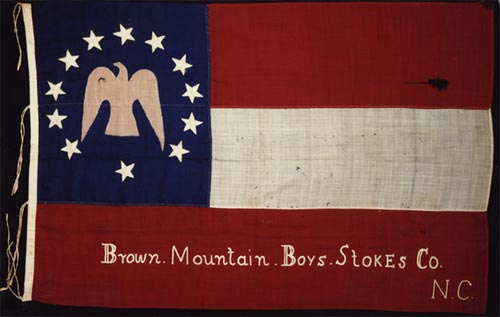
Over the past few months, I’ve been doing a lot of research on my family’s Civil War history, and I decided to write up a short guide on what I’ve learned in the process.
Ask Family
Now, before you go off trying to scour the web for all this sort of stuff by yourself, make sure you have consulted the single best source of information about your family that exists: your family. The biggest mistake you can make is to put in hours and hours of research, only to gain an inkling of something you could have found out for sure and right away if you had just asked a parent or grandparent. Don’t give up if they don’t come up with an answer right away. Ask to see photo albums, perhaps some old family letters, if they have them. You’d be surprised what people hold on to (and what they forget they have).
Best case scenario, you may find that someone has already done most of the work for you, but even if that’s not the case, this gives you a starting point; some little bits of information to look for to know you’re on the right track when you’re conducting your main research. This might be a person, a cemetery, a tiny snippit of a story that has survived the generations, anything. If nothing else, try to start putting together a family tree that goes back a few generations.
Extend Your Family Tree to the Time of the War
FindAGrave
Now, on to the stuff you can do by yourself. Depending on how far back the information you have goes, you’ll first want to make sure it extends back to the time of the war. If your family’s lore doesn’t go back quite that far, the first place I’d go is findagrave.com. This is, first and foremost, a website designed to help people find the burial locations of deceased relatives and other persons of interest. Fortunately, though, it also allows the grave pages for relatives to be linked together, so if you find the grave for someone in your tree, you can click your way back as far as the site will take you (make sure you double check you have the right person first; ask someone who has probably actually visited the gravesite if you have the right one).
Now, be advised that, while this resource is generally quite good, it is very hit-or-miss. A given individual might have family linked back several hundred years, or not have any family linked at all. You may, again, find that someone has done the work for you and written up a detailed bio of an ancestor of yours who served, or there may not be a word about him, or even a picture of his headstone.
In that latter case, you should keep in mind that just because a person’s father or mother is not linked to their page on this site does not mean they themselves are not on the site. Often, in cases where a person does not have any family linked, the family will be named in the bio. Check the site for them specifically and see if you can find anyone who has been linked in with a larger tree.
FamilySearch
You’ll probably make at least some headway with FindAGrave, and remember that you don’t have to find everyone at once; if one branch goes back far enough, but another doesn’t, you can always return to the mystery branch later. If however, there is a line of interest that FindAGrave does not have well documented in its database, the next place to look is familysearch.org. Its collection of records is, of course, not as extensive as that of ancestry.com, but all of the basics (marriage records, death certificates, the US census) are covered, and, unlike Ancestry, FamilySearch is free of charge (although you are required to make an account in order to use it).
The basics are pretty self explanatory: search for the last person you left
off with in your tree, verify with some details (names of relatives are the best
way to go), and start working your way backward, connecting people with their
parents through their death certificates and the US census, wherein they will be
listed in the same household.
I could never enumerate all of the little tricks that you need to know to use a site like this effectively (and I certainly don’t claim to know all of them myself), but here are some of the big ones:
- Learn to take age with a large grain of salt. Most people really didn’t keep very close track. Within a couple of years is totally plausible, and if the names of family check out, but the age is totally wrong, it’s still probably the right person.
- For determining parentage, start with the death certificate (don’t even bother looking for birth certificates; you’re not gonna find them), because they list the maiden name of the mother. Even if the father’s name is not given in full, you can use the maiden name to look for the marriage record, which will also have the bride’s maiden name.
- Full marriage records contain lots of information about family, including the parents of both the bride and groom by first name (at least in North Carolina, where I’ve been doing most of my research), so be on the look-out for these.
- Be sure to look for alternate spellings of names, or common nicknames. If
you’re not finding
Martha,
search forMattie;
if notSarah,
then maybeSally.
Maybe whoever you’re looking for went by his middle name most of the time. This is especially something to keep in mind if the person’s FindAGrave page lists them as having anickname.
Definitely be sure to search by that name. Sometimes it gets even weirder, like when handwritten records have been mistranscribed. One particular man in my tree named "Samuel" at one point had his name transcribed asSaul
(probably writtenSaml
). - If you suspect you may have found somebody’s mother or father, but aren’t quite sure, look at the names of the other people that you know are related to them. Look for repeated names; it was (and is) very common for people to be named after others in their family.
Find out Who Might Have Served
By this point, you hopefully have a fairly good picture of who your family was and where they were in the mid 19th century. Now it’s time to find out if and how they were involved with the military. The first place to look is the Civil War Soldiers and Sailors Index at the National Park Service website. Narrow down those in your tree to those who were between about 15 and 30 in the early 1860s and start searching their names (be sure to filter your results to the state where they lived, or at least those nearby).
You’re probably going to get quite a few results for each name, and figuring
out exactly which one, if any of them, is your relative is probably going to be
the biggest challenge you face. There is an article
on the National Archives website that outlines some tips for people facing
this exact dilemma (the focus is on Confederate soldiers because this problem
tends to be more pronounced for them due to many Confederate records being
incomplete, but the methodology is pretty universal). Be sure to read it for
the full details, but the gist of it is that you should focus on the soldier in
the unit that also tends to contain names of people who lived close by to your
relative (at the time, military companies were generally made up of people from
the same area, typically a county, hence company nicknames like the Guilford
Grays
), according to census records, etc. (keeping him with a known group
of associates
).
This is very helpful advice, but it’s not always necessary to go quite that
far. I would, again, start with the soldier search page linked above. On the
right-hand side of the page, across from a soldier’s name, there will be two
things you’ll want to look at. The first is a link to a brief descriptive page
about the soldier’s unit, which will typically list the counties from which the
soldier’s regiment recruited. If you find a unit that recruited from the area
where your relative lived (and there usually aren’t nearly as many of these),
there’s a pretty good chance that you’ve found your man. Just below that, you
may or may not see an Alternate Name.
These are just different ways that
the same soldier’s name was written on various documents. Lots of soldiers have
them, and they often reveal more information about a soldier’s name (like middle
names). These are also very helpful in determining if you have the right
person, and some really weird stuff can happen with them sometimes, so
absolutely do not forget to look at them. For example, I at one point searched
for Michael Fogleman
in the index, and got a hit, and at that, one that
was from the area of the man I was looking for. Only when I looked at the
Alternate Name did I realize that this soldier’s name was, in fact, Oliver
Fogleman,
definitely not the man I was looking for.
At this point, it’s probably also a good idea to return to FamilySearch and gather as much information on this particular individual as you can find. Look for unique-ish specifics (a relative with an unusual name is a particularly good one; specific birth dates with a month and day are helpful; age in years, as I mentioned before, usually isn’t super helpful, except on order of decades). The more you know about your relative, the more easily you can determine if the soldier whose records you’re looking at is the same man.
Gather More Information From Pensions
The NPS’s search page is helpful, but it only provides so much detail. You’ll find a soldier’s name as he gave it when he enlisted, his rank, and the company in which he served, but that’s about it. Even if he was from the correct area, that’s not a lot to go on to draw a connection to your family, and it certainly doesn’t say anything about what the soldier actually did during the war. For more information about the soldier personally, the first place to look is his pension, if he had one. Most soldiers, or their widows, children, or other dependents, applied for a pension for their service at some point after the war. These are the most promising place to look for information that will verify whether a given soldier is or is not the family member you suspect he may be.
Namely, these records will usually have an age and an exact county of residence. Even better, if the application was filed not by the soldier himself, but instead by a relative who was dependent on him, you get the name of that relative, which is extremely helpful for determining if you have the right man. Or, if you’re really, really lucky, the veteran may go into detail on some of his war experiences (so as to qualify for greater benefits to compensate for an injury of some kind).
If you’re from the South, then you’re in luck, because Confederate pensions were handled entirely by the states that made up the CSA (and some that did not, but had a large population who served in the Confederate forces, like Kentucky), so many of the records relating to these pensions can be viewed and downloaded for free from state websites (here are the links for North Carolina and South Carolina). Union pensions, unfortunately, cannot be obtained this way, but on the bright side, they usually contain a lot more information. But before we get to Union pensions, I want to briefly introduce the next resource we’ll be using.
Use What You’ve Found to Pull Records from Fold3
By this point, you hopefully have some or all of the basics about both your relative, and one or two soldiers that you suspect may be him. Or, if you’re looking at a Union soldier and couldn’t get at a state pension, then maybe still just a name and rough area of residence. Now we come to the resource where you can find some of the most interesting records: Union pensions and the official War Department records pertaining to specific soldiers. At the time I write this, the only place online that I know of to find these is the Ancestry-run fold3.com, which focuses specifically on military records. Part of the reason I haven’t mentioned it until now is because it is the only resource I’ve linked on this page that requires a fee. Hopefully, by this point in your research, you have enough information about your persons of interest that you can get in, grab the records you want, and get out in as short a time as possible. My recommendation is that you absolutely exhaust all of the resources I have mentioned up until now and write out a list of all of the people you think you might want the records for, even if you’re not yet 100% sure they’re the right ones. Then, sign yourself up for a fourteen-day trial on Fold3 and download, download, download! (When you’re viewing an image record, hover over the little hammer-and-wrench icon in the top right and click download, then download the entire page as a JPEG. Do this for every page in the record; it’s tedious, but this way you get the whole thing in the best quality available.)
Back to Union Pensions
But I’m getting ahead of myself. What exactly is it you’re looking for? Well, if you’re researching a Union soldier, you’ll definitely want to see if you can find a pension for him on Fold3. As I said before, Union pensions are particularly helpful and interesting because, while Confederate pension records are typically limited to the application, Union pensions can contain all kinds of things: local records in addition to Federal ones, copies of enlistment and discharge papers, and sometimes even personal correspondence related to the matter of attaining the pension. This means that, in addition to ages, residence, and other basic stuff, you may get the names of family and neighbors (as I keep saying, easily some of the most valuable information when doing geneology), and who knows what else. On top of being super helpful in verifying if you have the right soldier, they’ll often indicate interesting facts about his life in their own right, which is the end goal, after all.
The Exciting Part
So, let’s recap what you’ve done so far. (1) You’ve built up a family tree that, at least in parts, extends back to the time of the Civil War. (2) You’ve identified your male ancestors from the period who would have been in the right age group to have served. (3) You’ve used online resources like FamilySearch to gather as much information about your relative who may have served as you can. (4) You have searched for this person in the Civil War Soldiers and Sailors Index and found a potential match. (5) You have used the information provided by the index, as well as pension files, to gather as much information about the soldier as possible. (6) You have used the information on both people to determine if you have the right man and, if you do, begun putting together a basic picture of his military service.
By this point, most of the hard stuff is probably behind you. Now comes the
most interesting and rewarding part. You may have noticed in the outline above
that something is conspicuously missing: finding out what your soldier
actually did during the war. This brings us to what are known officially
as Compiled Military Service Records, or CMSRs. These records were
originally made by the War Department to allow the government to more easily
verify claims relating to veterans’ benfits. They basically consist of a series
of cards containing all of the information on a particular soldier as it was
found on the original documents from the war, most commonly muster rolls. Each
of the cards in the record represents the appearance of an individual’s name on
one of these documents, and contains all of the information pertaining
specifically to him from that document. These records, as they were originally
made, exist as physical pieces of paper in the National Archives, but to allow
for easier viewing, they were copied onto something called microfilm,
which has, in turn, been digitally scanned and uploaded to sites like Fold3. To
give you an idea, they usually look like this:
An example CMSR cover (left) and body page (right).
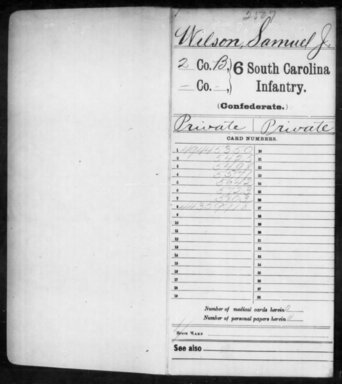
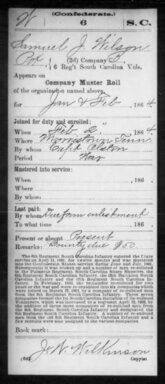
CMSRs can contain a lot of information: basic physical descriptions, records of wounds or capture in battle, requisitions for clothing and other supplies from the army, hospitalization for injury or illness, and, if your really lucky, copies of such documents as enlistment and discharge papers. In short, you definitely want these. The National Archives has a pretty detailed article (much of which is echoed here) about CMSRs and how they can be used to piece together a story of a given soldier’s service.
One final note before we move on to our final resource: The search
functionality on the NPS website is much, much more generous than that of Fold3,
so don’t panic or get confused if you don’t immediately find the record you’re
looking for. Probably what has happened is that the record was filed under a
slightly different variation of the name than the one you’re searching for.
Recall the Alternate Name
that some soldiers have on the NPS search page.
Search for this instead, and you’ll probably find the record you’re looking
for.
Find the Record of Events For Your Soldier’s Company
If you’ve looked closely at some CMSR muster roll cards, you’ve probably noticed something a little weird; they say if the soldier was with his company, but not where the company actually was. Not to worry, this information is out there, it’s just in a different set of records. Recall a second ago when I mentioned how CMSRs were created by copying the information from original muster rolls and the like onto cards like the ones pictured above. While the information about individual soldiers was copied into soldiers’ CMSRs, all of the rest of the information on those same documents was copied onto a set of cards for the company as a whole called the Record of Events. The Record of Events cards look very similar to CMSR cards, but notice how, instead of being for particular soldiers, they are for entire military units (in the example below, Company B of the 6th Regiment South Carolina Infantry):
An example Record of Events cover (left) and body page (right).
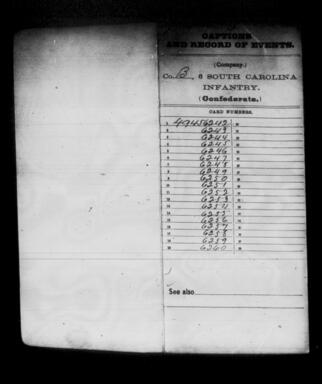
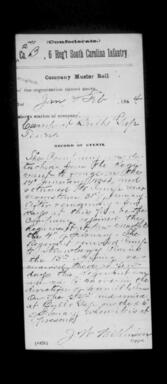
Fortunately, though, unlike CMSRs, these records can be accessed online for
free (here are the links for the Confederacy
and Union).
The downside here is that, also unlike with the CMSRs, there’s not a simple way
to search these records, but that doesn’t mean you have to manually read through
every single page to find your soldier’s unit. The microfilm of these records
is organized into rolls
(of film), and there is an index of which
military units’ records are on which rolls that you can use to more quickly
locate the ones you’re looking for (again, here are the links for the Confederacy
and Union).
Now, each roll has its own separate page on those archive.org links I provided
above, and to find the one you want, you’ll have to make a slight change to the
URL. As provided, they should look like this:
The URL for the Confederate Record of Events microfilm scans. Note the roll number, shown in bold.
Those four digits that I’ve bolded are the roll number. Simply replace that number with that of the roll you’re looking for (be sure to pad it with zeros to make it four digits), and you should be taken to the page for that roll, at which point you can begin looking through it for the records you’re interested in. For example, if I wanted to find the Record of Events for the 3rd North Carolina Artillery, I would follow the Confederate index link, and find that the records for that unit are on roll number 37:
An excerpt from the index of Record of Events microfilm rolls. Note that the records for the 3rd NC Artillery are on roll 37.
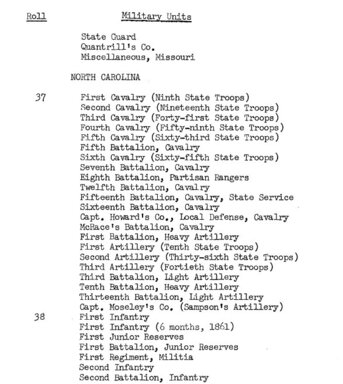
Knowing that, I would follow the Confederate microfilm record link, and change the URL to this:
The URL for roll 37 of the Confederate Record of Events microfilm scans.
As a reviewer on the page I linked for the Confederate records describes, some of the records in that collection have been mislabeled, so in a few cases, you’re not going to get the right roll. I guess I got lucky, because I didn’t run into this problem. If the URL you enter ends up taking you to something that is obviously not what it should be, the same NARA page I linked earlier describes some other places to look, but they’re a little more of a pain in the neck to get to.
At the very least, the Record of Events will name where the company was stationed when it filled out the muster roll, and you can correlate these muster roll cards with those in the CMSRs of individual soldiers to determine, for sure, where the soldier was at a given time. In my experience, this is all you’ll be able to do for most units, so don’t get your hopes up too high for an exciting story. But don’t be disappointed either; this is still great information. With some outside research on what was happening and where during the war, you can still piece together a rough narrative of what a given soldier was up to and why, which is pretty much the whole point of this little exercise.
However, if you get lucky (I feel like I’ve been saying that a lot), some Records of Events will have actual detailed descriptions of the specific activities of the company during a given time period. So much the better.
Conclusion
So that’s a summary of tactics and resources that I’ve learned about in conducting research about my family members in the Civil War. I’m certain there is loads more that I’ve just forgotten to include, to make no mention of the untold volumes worth that I don’t know about at all (I’m still a novice at this), but I feel like it’s a pretty comprehensive guide to/summary of the most readily available and easily digestible resources for this particular research topic. I can only say that I hope someone finds this guide helpful.
As a final note, I would like to emphasize that I feel very strongly that everyone should do a little bit of this kind of family research from time to time. There’s so much knowledge about our world that we just take for granted, and unless we make a specific effort to document it, it will eventually simply fade away. Don’t let that happen. Every man deserves to know exactly who he is.


